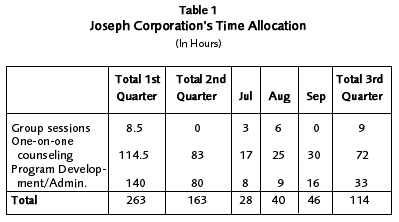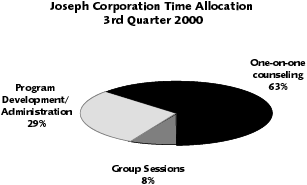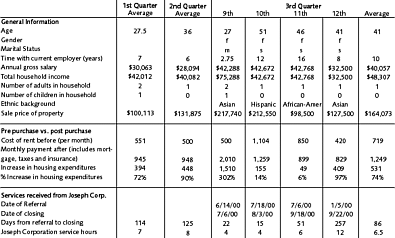The EAH initiative at west suburban System Sensor continues to thrive in partnership with Joseph Corporation and MPC.
Regional Employer-Assisted Collaboration for Housing
This is the third quarterly report on the Employer-Assisted Housing (EAH) model initiated by the Metropolitan Planning Council (MPC) in collaboration with nonprofit housing organizations and regional employers. The first initiative is underway at the St. Charles-based System Sensor plant, in partnership with the Joseph Corporation of Aurora, a community-based housing development and counseling agency.
System Sensor, which is owned by Honeywell International, Inc., is a fire alarm systems manufacturing company which employs more than 900 people in a 160,000 square-foot facility.
St. Charles is a predominantly residential community in Kane County, Illinois. The average sale price of a single family home for 1998-1999 was $274,502. That's far above $166,200, the average price of homes purchased by first-time buyers in the Chicago region.1
This EAH initiative exemplifies the company's commitment to maintaining its business edge through innovative workforce benefits. This program assists employees in buying homes close to the worksite, thus reducing employee commutes, tardiness, and turnover.
"As a manufacturing company in a high-cost housing market and a tight labor market, we at System Sensor face significant training and recruitment costs when workers leave. We are committed to offering benefits to reduce turnover," explained System Sensor Human Resources Director Dick Braun.
The Program
System Sensor and Joseph Corporation held a homeownership fair in December, 1999, where an EAH Employee Information Package and an Employee Eligibility Application were distributed among interested employees. Human Resources staff and representatives of Joseph Corporation described the program, answered questions, and discussed homeownership options. In response to extensive interest documented by initial employee surveys and this homeownership fair, System Sensor launched its Employer-Assisted Housing pilot program in January 2000.
In 2000 and 2001, System Sensor will provide up to 25 employees with $5,000 forgivable loans to be applied toward down payment and closing costs on homes close to the plant. Joseph Corporation works with employees, providing pre- and post-purchase counseling. "Credit history is one big stumbling block to homeownership, so we designed our counseling services to address that barrier," explained Greg Schiefelbein, Executive Director of Joseph Corporation. "Counseling helps a great deal and is not too expensive," added System Sensor's Braun.
System Sensor and Joseph Corporation have set a goal: 50 employees becoming homeowners by the end of 2001. "Since this (2000) was the first year for the program we may not reach the 25 new buyers we'd aimed for. We found that the $5,000 alone wasn't sufficient to get employees in our door for counseling. They need a friend and an advocate - someone to walk them though the homebuying process and provide friendly encouragement when they meet obstacles. Now that we've added new staff and can be more proactive, Joseph Corporation is able not only to educate but to motivate," said Schiefelbein. Braun expressed surprise that more people have not applied to participate in the program. "Maybe they still don't believe this program is real. Some don't believe that we are really offering $5,000."
As of the end of the third quarter, 59 System Sensor employees had attended homeownership counseling sessions at Joseph Corporation and twelve had become homeowners.
During the third quarter of 2000, eighteen additional employees had completed the Employee Eligibility Application and were referred to Joseph Corporation to start the homeownership counseling and education process.
Employees are at various stages of the home buying process. Some are one to two years away from homeownership, due to credit problems or high levels of debt. Others facing smaller hurdles are only months away. Still others are ready to buy, but have not yet found their dream house. The last group includes those who have a household income of less than $25,000 and cannot afford to purchase a house costing more than $60,000. There are very few homes at that price near System Sensor in Kane or nearby DuPage counties.
Turnover and Estimated Cost Savings
System Sensor's primary objective was to reduce turnover and decrease training and recruitment costs. In the third quarter, the first participating buyer left System Sensor. Said Braun, "While we are disappointed to lose a worker, we are very enthusiastic about this program. It's hard to determine in less than a year exactly what effect this program has had on turnover, but we are confident that it makes us a more attractive company." Because the $5,000 downpayment assistance provided by System Sensor was structured as a loan to be forgiven at 20% per year for five years, this ex-employee was responsible for repaying System Sensor $4,500. Schiefelbein noted, "We can't predict people's behavior, but we've learned that the hard work System Sensor and Joseph Corporation put into designing our program documents paid off. We have to anticipate that some participating homebuyers will leave System Sensor and have structured our documents accordingly."
Despite the departure of one participating employee, System Sensor expects to see cost savings due to reduced employee turnover. With Fannie Mae and MPC assistance, the program's costs and savings are being monitored.
After comparing the per employee cost of turnover, relocation and training to the per employee cost of the EAH program, savings to System Sensor are projected to exceed $100,000 by the end of the program's first year.
Joseph Corporation Participation
Table 1 shows how Joseph Corporation utilized its time in the System Sensor EAH program. During the third quarter of 2000, Joseph Corporation devoted 114 hours to System Sensor's EAH program. This represents an average of 38 hours per month, a significant decrease from the first and second quarters. Yet the results remain consistent - four successful new homebuyers each quarter.
Table 1
Joseph Corporation's Time Allocation (In Hours)

Source: System Sensor EAH Quarterly Report. Joseph Corporation (Nov., 2000)
From the first to the third quarters of 2000, the number of hours spent on one-on-one counseling and on program development and administration has decreased significantly. Program development/ administration refers to time spent creating the EAH model, working with banks and attorneys and closing the loans. As the program has taken off, Joseph Corporation has reduced time spent on program administration. The bulk of their time (71%) has instead been devoted to counseling sessions with prospective buyers. (See Illustration 1.) It is expected that, as the program continues to expand, Joseph Corporation will continue to decrease planning workloads and increase homeownership counseling and educational services.
Illustration 1

Source: System Sensor EAH Quarterly Report. Joseph Corporation (Nov., 2000)
What type of housing did System Sensor employees purchase?
Table 2 profiles the four System Sensor employees who purchased homes during the third quarter of 2000. These employees had worked for System Sensor an average of 10 years at the time they purchased their homes. Their average gross income is $40,057. System Sensor employees that bought homes during the third quarter of 2000 paid an average of $164,073 for their homes. The noticeable increase in post-purchase housing expenditures shows the importance of Joseph Corporation's efforts to ensure new homeowners establish a solid financial base through quality credit counseling and homebuyer education.
Table 2
Employee Homebuyer Profile

Source: System Sensor Individual Reporting Form. Joseph Corporation (November 2000)
Benefits For Surrounding Communities
All but two of the twelve EAH participants in 2000 were first-time homebuyers. This indicates that, in addition to stabilizing the workforce, this program is contributing to the local communities and to Kane County at large. The aggregate value of all properties bought by System Sensor employees is more than $1.5 million, producing a net benefit in real estate taxes of approximately $37,500 ($1,500,000 x 0.025). For these twelve employees, System Sensor has committed downpayment assistance in the amount of $60,000. If System Sensor and Joseph Corporation reach their goal of 25 new homeowners this year, System Sensor will have made forgivable loans amounting to $150,000, and the aggregate value of those homes will likely reach $3,300,502. This amount would represent a net benefit in real estate taxes of approximately $82,500. Local communities would realize more than fifty cents in property taxes for every dollar System Sensor invests in downpayment assistance.
Although employees still could not afford homes in pricey St. Charles, they stabilized their housing situation by becoming homeowners in nearby communities such as Aurora, North Aurora, and Geneva. The average price paid by System Sensor employees ($164,073) was slightly below the regional average of $166,200 for first-time homebuyers. More impressively, the average household income of participating families was approximately $48,000 a year, substantially lower than the average first-time homebuyers in the region - $60,700.
These families succeeded in crossing the bridge to homeownership. No wonder System Sensor's EAH pilot program is becoming a model for regional efforts to expand housing options near employment.
Illustration 2

Source: 24th Annual Survey of Recent Home Buyers, Chicago Magazine (October 1999)
National Model
Local news articles have focused on the System Sensor employer-assisted housing model, highlighting the challenges facing local employers. A series of stories that ran in the Daily Herald between October 25 and November 6, 2000, carried headlines such as: Businesses sign up to help employees find places to live; Many professionals can't afford home; Lack of affordable housing threat to area's economy; and Assisted housing helps keep workers happy.
The national media have also begun to take note. The Wall Street Journal included a front-page mention of the program on October 10, 2000. Newsweek, in its October 30, 2000 issue, featured the program in an article headlined No Place Like Home: A tight labor market leads to a cozy new perk with a photo of King Harris in front of one of his employees' new homes. This local model is inspiring people all over the country to think about employer-assisted housing.
For more information contact Samantha DeKoven, Housing Associate, Metropolitan Planning Council at (312) 922-5616 x145, or Greg Schiefelbein, Executive Director, the Joseph Corporation at (630) 906-9400.
MPC is deeply grateful to the following whose funding made this work possible:
-
Woods Fund of Chicago
-
Fannie Mae Foundation
-
Bank of America
-
U. S. Bancorp Piper Jaffrey
-
Pittway Corporation Charitable Foundation
-
North West Housing Partnership
1 Source: 24th Annual Survey of recent Home Buyers, Chicago Magazine (October 1999.)